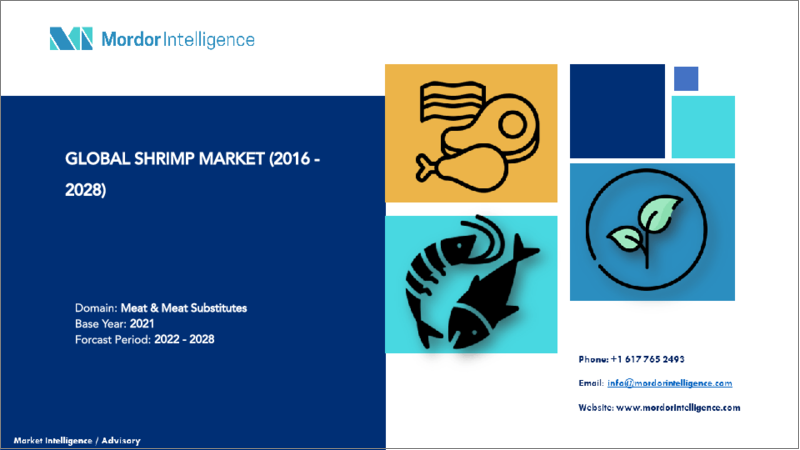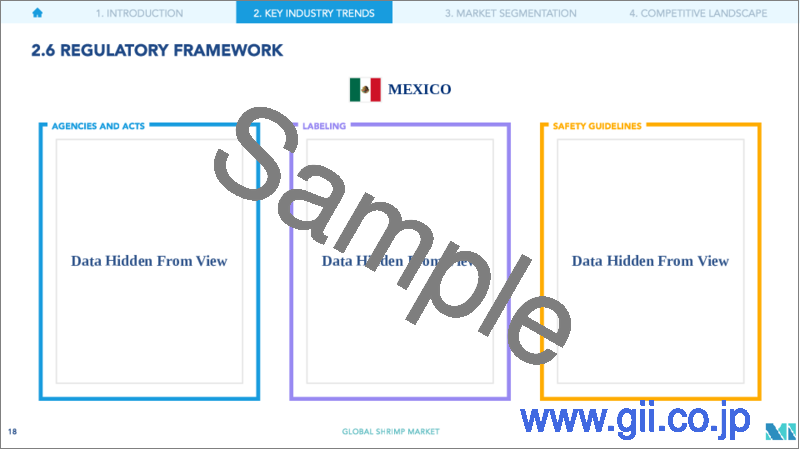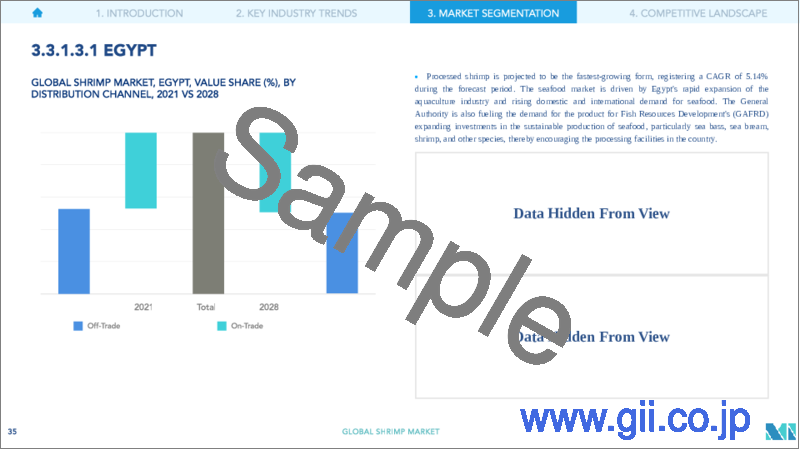|
|
市場調査レポート
商品コード
1188827
エビの世界市場-2028年までの市場規模、シェア、予測Global Shrimp Market - Size, Share, & Forecasts up to 2028 |
||||||
|
● お客様のご希望に応じて、既存データの加工や未掲載情報(例:国別セグメント)の追加などの対応が可能です。 詳細はお問い合わせください。 |
|||||||
価格
| エビの世界市場-2028年までの市場規模、シェア、予測 |
|
出版日: 2023年01月18日
発行: Mordor Intelligence
ページ情報: 英文 363 Pages
納期: 2~3営業日
|
ご注意事項 :
本レポートは最新情報反映のため適宜更新し、内容構成変更を行う場合があります。ご検討の際はお問い合わせください。
- 全表示
- 概要
- 目次
概要
エビの世界市場のCAGRは2.23%と予測されています。
主なハイライト
- 地域別最大市場:アジア太平洋地域:アジア太平洋地域はインド、タイ、中国などの国々を中心にエビの生産量が多く、同地域での供給が容易なため、消費量の増加に繋がっています。
- 形態別最大品目:冷凍/缶詰:冷凍エビは生鮮エビに比べて価格が安いことが需要の主な要因です。缶詰は輸送の手軽さからネット通販で人気が高いです。
- 地域別売上高成長率:南米:既存養殖場の拡張、増産、エビ価格の下落、新たな客層へのエビの紹介などが要因。
- 加工品:すぐに食べられる、すぐに調理できる食品へのニーズの高まりから、エビの加工品への需要が高まっています。オンライン流通経路からの売上が高いです。
エビの市場動向
流通経路別では、オントレードが最大セグメント。
- 2021年のエビの売上は、2020年から2021年にかけて23.83%増加したオントレードチャネルの売上増により、金額ベースで前年比6%増となっています。米国、中国、マレーシア、インドなどでは、約70%の人が外食で水産物を摂取することを好んでいることも背景にあります。同時に、可処分所得の上昇も、売上をさらに押し上げる大きな要因となっています。オントレードチャネルは、パンデミック関連のロックダウンが緩和された後、2021年には前年比23.83%増となったため、60%以上の大きなシェアを占めています。
- オンラインチャネルは、予測期間2022-2028年のCAGR(金額ベース)が9.24%となり、最も成長率の高いチャネルになると予測されます。オンラインチャネルを通じた売上は、オフラインの店舗が閉鎖され、人々が家から出ることが制限されたため、COVID-19の大流行により2019年から2020年にかけて116.16%強化されました。Amazon、Walmart、The Kroger Co.などの大手オンラインストアは、ASC認証の商品を多く発売し、オンラインのシーフードの購入率は57%に増加しました。
- 取引外チャネルのうち、スーパーマーケット/ハイパーマーケットは2021年に60%以上のシェアを占めています。COVID-19の大流行後、スーパーマーケット/ハイパーマーケットを通じた売上は、2019年から2021年にかけて金額ベースで22.8%減少しました。これは、2020年にGDPが7%減少した欧州の経済危機と、GDPが2.3%に減少した米国の経済危機がある程度影響しています。消費者はナショナルブランドではなく、プライベートブランドに切り替えており、南米のホワイトシュリンプ、アジアのホワイトシュリンプ、エビのパン粉焼き製品など、さまざまなエビ製品が提供されています。
地域別ではアジア太平洋地域が最も多いです。
- 2021年のエビの売上高は全地域で26.97%増加しました。消費者の可処分所得の増加や健康志向に伴い、オメガ3脂肪酸、セレン、タンパク質を含み、エキゾチックでプレミアムな味わいのエビのような高タンパクなシーフードの採用が急増しています。
- 2021年、COVID-19のパンデミックなどにより、エビの売上高の前年比成長率が6.05%と急増しています。2020年には、輸出入や物流が混乱し、サプライチェーンの有効性と効率性が高まっています。その結果、サプライチェーンにおける無駄が減少し、生産量も増加したため、世界の需要にマッチするようになっています。2021年にインドのエビの生産量は8~9%増加し、多くの生産者がフードサービスなどの流通経路ではなく、小売に軸足を移しました。例えば、米国では生産者や取引業者がB2BからB2Cにシフトし、価格差益を拡大させました。
- アジア太平洋はエビ市場を独占しており、北米より41%、欧州より41.5%高い市場シェアを誇っています。これは主に人口によるもので、世界人口の約59%がアジアに住んでいます。インド、タイ、中国などエビの生産国が多く、世界の生産量の約58%を占め、生産されたエビの49%は地元で消費されています。残りは米国など他国へ輸出され、プレミアム価格で取引されている
- 南米はエビ市場の中で最も成長率が高く、2022~2028年の予測期間中に金額ベースで3.77%のCAGRで推移すると見られています。同国は、エビのプレミアム品質と価格で知られています。投資と高級エビの需要の増加は、市場を牽引することが期待されます。例えば、著名な市場プレーヤーであるVitaproは、8000万米ドルを投資しました。
エビ市場の競合分析
世界のエビ市場は断片的であり、上位5社で5.01%を占めています。
その他の特典
- エクセル形式の市場予測(ME)シート
- アナリストによる3ヶ月間のサポート
目次
第1章 エグゼクティブサマリー&キーファインディング
第2章 イントロダクション
- 調査の前提条件と市場の定義
- 調査対象範囲
- 調査手法
第3章 主要な産業動向
- 価格動向
- 生産動向
- 規制の枠組み
- バリューチェーンと流通経路分析
第4章 市場のセグメンテーション
- 形態
- 生鮮・冷蔵
- 冷凍/缶詰
- 加工品
- 流通経路
- オフトレード
- コンビニエンスストア
- オンラインチャネル
- スーパーマーケット、ハイパーマーケット
- その他
- オントレード
- オフトレード
- 地域別
- アフリカ
- 形態別
- 流通経路別
- 国別
- エジプト
- ナイジェリア
- 南アフリカ
- その他のアフリカ地域
- アジア太平洋地域
- 形態別
- 販売チャネル別
- 国別
- オーストラリア
- 中国
- インド
- インドネシア
- 日本
- マレーシア
- 韓国
- その他アジア太平洋地域
- 欧州
- 形態別
- 流通経路別
- 国別
- フランス
- ドイツ
- イタリア
- オランダ
- ロシア
- スペイン
- 英国
- その他欧州
- 中東地域
- 形態別
- 販売チャネル別
- 国別
- バーレーン
- クウェート
- オマーン
- カタール
- サウジアラビア
- アラブ首長国連邦
- その他の中東地域
- 北米
- 形態別
- 販売チャネル別
- 国別
- カナダ
- メキシコ
- 米国
- その他北米地域
- 南米
- 形態別
- 販売チャネル別
- 国別
- アルゼンチン
- ブラジル
- その他の南米地域
- アフリカ
第5章 競合情勢
- Key Strategic Moves
- 市場シェア分析
- Company Landscape
- 企業プロファイル
- Admiralty Island Fisheries Inc.
- Anchor Trust Group Limited
- Beaver Street Fisheries
- Dulcich Inc.
- Industrial Pesquera Santa Priscila S.A.
- Maruha Nichiro Corporation
- Nippon Suisan Kaisha Ltd
- Premium Brands Holdings Corp.(Clearwater Seafoods Incorporated)
- Roda Internacional Canarias, S.L.
- Sysco Corporation
- Thai Union Group PCL
- The Waterbase Ltd.
第6章 CEOへの主な戦略的質問
第7章 付録
- 世界概要
- 概要
- ポーターのファイブフォースフレームワーク
- 世界バリューチェーン分析
- 市場力学(DRO)
- 出典・参考文献
- 表と図のリスト
- プライマリーインサイト
- データパック
- 用語集
目次
Product Code: 92487
The Global Shrimp Market is projected to register a CAGR of 2.23%
Key Highlights
- Largest Segment by Region - Asia-Pacific : Asia-Pacific largely produces shrimps, mainly in countries like India, Thailand, and China, which supports its easy supply in the region, leading to higher consumption.
- Largest Segment by Form - Frozen / Canned : Lower prices of frozen shrimp relative to fresh shrimp are the key reason for its demand. Canned shrimp is popular on online channels due to its ease of shipping.
- Fastest-growing Segment by Region - South America : The growth in regional sales is due to the expansion of existing shrimp farms, production increase, falling shrimp prices, and the introduction of shrimp to a new audience.
- Fastest-growing Segment by Form - Processed : The growing need for ready-to-eat and ready-to-cook food products gave rise to the demand for processed shrimp. The sales are higher from the online distribution channel.
Shrimp Market Trends
On-Trade is the largest segment by Distribution Channel.
- In 2021, shrimp sales observed a Y-o-Y growth of 6%, by value, compared to the previous year owing to increased sales through the on-trade channel, which rose by 23.83% from 2020 to 2021. This was also because around 70% of people in countries like the United States, China, Malaysia, India, and others prefer to dine out to consume seafood. At the same time, rising disposable incomes are another major factor that has further driven sales. The on-trade channel accounted for a significant share of more than 60% in 2021 because, after the easing of pandemic-related lockdowns, sales rose by 23.83% in 2021 compared to the previous year.
- The online channel is projected to be the fastest-growing channel with a CAGR, by value, of 9.24% during the forecast period 2022-2028. Sales through online channels were bolstered by 116.16% from 2019 to 2020 due to the COVID-19 pandemic, as offline stores were closed and people were restricted from stepping out of their homes. Major online stores like Amazon, Walmart, The Kroger Co., and others have launched more products with ASC certification, which has increased online seafood purchases to 57%.
- Among off-trade channels, supermarkets/hypermarkets accounted for more than 60% of the share in 2021. After the COVID-19 pandemic, sales through supermarkets/hypermarkets declined by 22.8%, by value, from 2019 to 2021. This was due to the economic crisis in Europe, where the GDP fell by 7% in 2020, and to some extent in the United States, where the GDP decreased to 2.3%. Consumers have switched to private label brands instead of national brands, which offer varieties of shrimp products, such as South American White Shrimp, Asian White Shrimp, and Breaded Shrimp Products.
Asia-Pacific is the largest segment by Region.
- The overall sales of shrimp in all the regions increased by 26.97% in 2021. With the increase in disposable income and health consciousness among consumers, there has been a spike in the adoption of high-protein seafood like shrimps with omega-3 fatty acids, selenium, and protein with exotic, premium taste.
- In 2021, there was a sudden spike in the Y-o-Y growth of shrimp sales by 6.05%, mainly due to the COVID-19 pandemic. In 2020, imports, exports, and logistics were disrupted, which led to an increase in the effectiveness and efficiency of supply chains. As a result, the wastage in the supply chain declined, and production also increased, thus matching the global demand. The production of Indian shrimp increased by 8-9% in 2021, and many producers shifted their focus to retail rather than foodservices and other distribution channels. For example, producers and traders shifted from B2B to B2C in the United States, increasing their price margins.
- Asia-Pacific dominates the shrimp market, with a 41% higher market share than North America and a 41.5% higher market share than Europe. This is mainly due to its population, as around 59% of the global population lives in Asia. It has more countries producing shrimp, such as India, Thailand, China, and others, which account for around 58% of global production, and 49% of the shrimp produced is consumed locally. The rest is exported to other countries like the United States for premium prices
- South America is likely to be the fastest-growing shrimp market and record a CAGR of 3.77% by value during the forecast period 2022 -2028. The country is known for the premium quality and prices of its shrimp. The increase in investments and demand for premium shrimp is expected to drive the market. For instance, prominent market player Vitapro invested USD 80 million.
Shrimp Market Competitive Analysis
The Global Shrimp Market is fragmented, with the top five companies occupying 5.01%. The major players in this market are Beaver Street Fisheries, Dulcich Inc., Maruha Nichiro Corporation, Nippon Suisan Kaisha Ltd and Thai Union Group PCL (sorted alphabetically).
Additional Benefits:
- The market estimate (ME) sheet in Excel format
- 3 months of analyst support
TABLE OF CONTENTS
1 EXECUTIVE SUMMARY & KEY FINDINGS
2 INTRODUCTION
- 2.1 Study Assumptions & Market Definition
- 2.2 Scope of the Study
- 2.3 Research Methodology
3 KEY INDUSTRY TRENDS
- 3.1 Price Trends
- 3.2 Production Trends
- 3.3 Regulatory Framework
- 3.4 Value Chain & Distribution Channel Analysis
4 MARKET SEGMENTATION
- 4.1 Form
- 4.1.1 Fresh / Chilled
- 4.1.2 Frozen / Canned
- 4.1.3 Processed
- 4.2 Distribution Channel
- 4.2.1 Off-Trade
- 4.2.1.1 Convenience Stores
- 4.2.1.2 Online Channel
- 4.2.1.3 Supermarkets And Hypermarkets
- 4.2.1.4 Others
- 4.2.2 On-Trade
- 4.2.1 Off-Trade
- 4.3 Region
- 4.3.1 Africa
- 4.3.1.1 By Form
- 4.3.1.2 By Distribution Channel
- 4.3.1.3 By Country
- 4.3.1.3.1 Egypt
- 4.3.1.3.2 Nigeria
- 4.3.1.3.3 South Africa
- 4.3.1.3.4 Rest Of Africa
- 4.3.2 Asia-Pacific
- 4.3.2.1 By Form
- 4.3.2.2 By Distribution Channel
- 4.3.2.3 By Country
- 4.3.2.3.1 Australia
- 4.3.2.3.2 China
- 4.3.2.3.3 India
- 4.3.2.3.4 Indonesia
- 4.3.2.3.5 Japan
- 4.3.2.3.6 Malaysia
- 4.3.2.3.7 South Korea
- 4.3.2.3.8 Rest Of Asia-Pacific
- 4.3.3 Europe
- 4.3.3.1 By Form
- 4.3.3.2 By Distribution Channel
- 4.3.3.3 By Country
- 4.3.3.3.1 France
- 4.3.3.3.2 Germany
- 4.3.3.3.3 Italy
- 4.3.3.3.4 Netherlands
- 4.3.3.3.5 Russia
- 4.3.3.3.6 Spain
- 4.3.3.3.7 United Kingdom
- 4.3.3.3.8 Rest Of Europe
- 4.3.4 Middle East
- 4.3.4.1 By Form
- 4.3.4.2 By Distribution Channel
- 4.3.4.3 By Country
- 4.3.4.3.1 Bahrain
- 4.3.4.3.2 Kuwait
- 4.3.4.3.3 Oman
- 4.3.4.3.4 Qatar
- 4.3.4.3.5 Saudi Arabia
- 4.3.4.3.6 United Arab Emirates
- 4.3.4.3.7 Rest Of Middle East
- 4.3.5 North America
- 4.3.5.1 By Form
- 4.3.5.2 By Distribution Channel
- 4.3.5.3 By Country
- 4.3.5.3.1 Canada
- 4.3.5.3.2 Mexico
- 4.3.5.3.3 United States
- 4.3.5.3.4 Rest Of North America
- 4.3.6 South America
- 4.3.6.1 By Form
- 4.3.6.2 By Distribution Channel
- 4.3.6.3 By Country
- 4.3.6.3.1 Argentina
- 4.3.6.3.2 Brazil
- 4.3.6.3.3 Rest Of South America
- 4.3.1 Africa
5 COMPETITIVE LANDSCAPE
- 5.1 Key Strategic Moves
- 5.2 Market Share Analysis
- 5.3 Company Landscape
- 5.4 Company Profiles
- 5.4.1 Admiralty Island Fisheries Inc.
- 5.4.2 Anchor Trust Group Limited
- 5.4.3 Beaver Street Fisheries
- 5.4.4 Dulcich Inc.
- 5.4.5 Industrial Pesquera Santa Priscila S.A.
- 5.4.6 Maruha Nichiro Corporation
- 5.4.7 Nippon Suisan Kaisha Ltd
- 5.4.8 Premium Brands Holdings Corp. (Clearwater Seafoods Incorporated)
- 5.4.9 Roda Internacional Canarias, S.L.
- 5.4.10 Sysco Corporation
- 5.4.11 Thai Union Group PCL
- 5.4.12 The Waterbase Ltd.
6 KEY STRATEGIC QUESTIONS FOR SEAFOOD INDUSTRY CEOS
7 APPENDIX
- 7.1 Global Overview
- 7.1.1 Overview
- 7.1.2 Porter's Five Forces Framework
- 7.1.3 Global Value Chain Analysis
- 7.1.4 Market Dynamics (DROs)
- 7.2 Sources & References
- 7.3 List of Tables & Figures
- 7.4 Primary Insights
- 7.5 Data Pack
- 7.6 Glossary of Terms
お電話でのお問い合わせ
044-952-0102
( 土日・祝日を除く )




